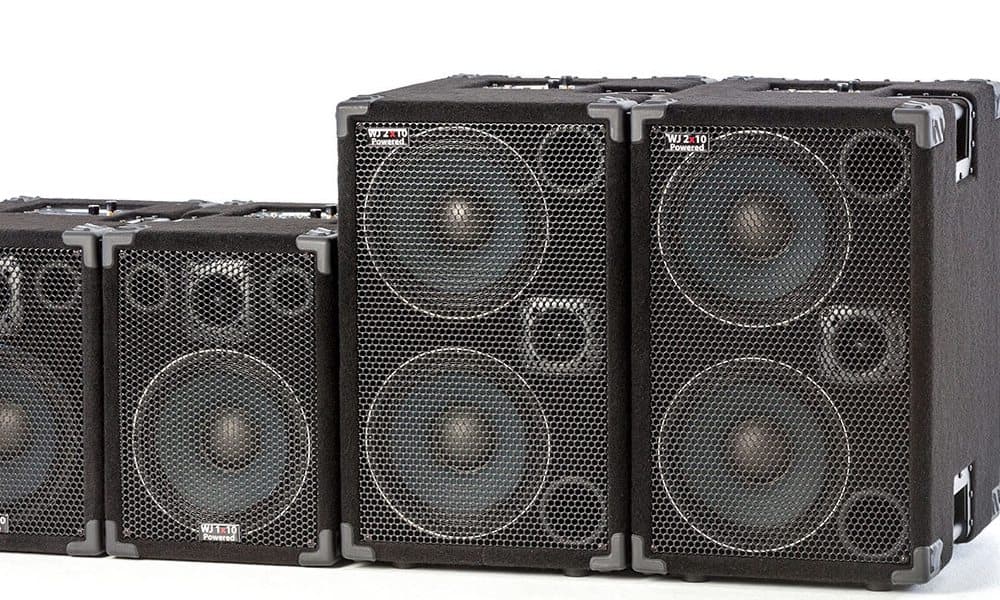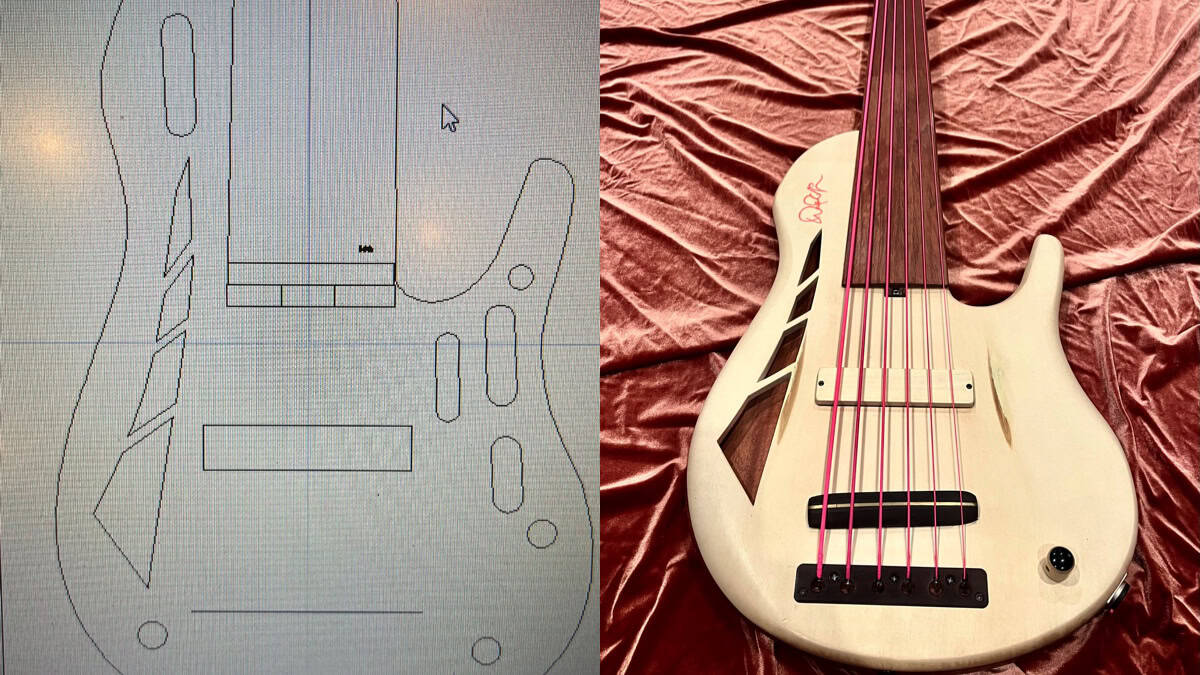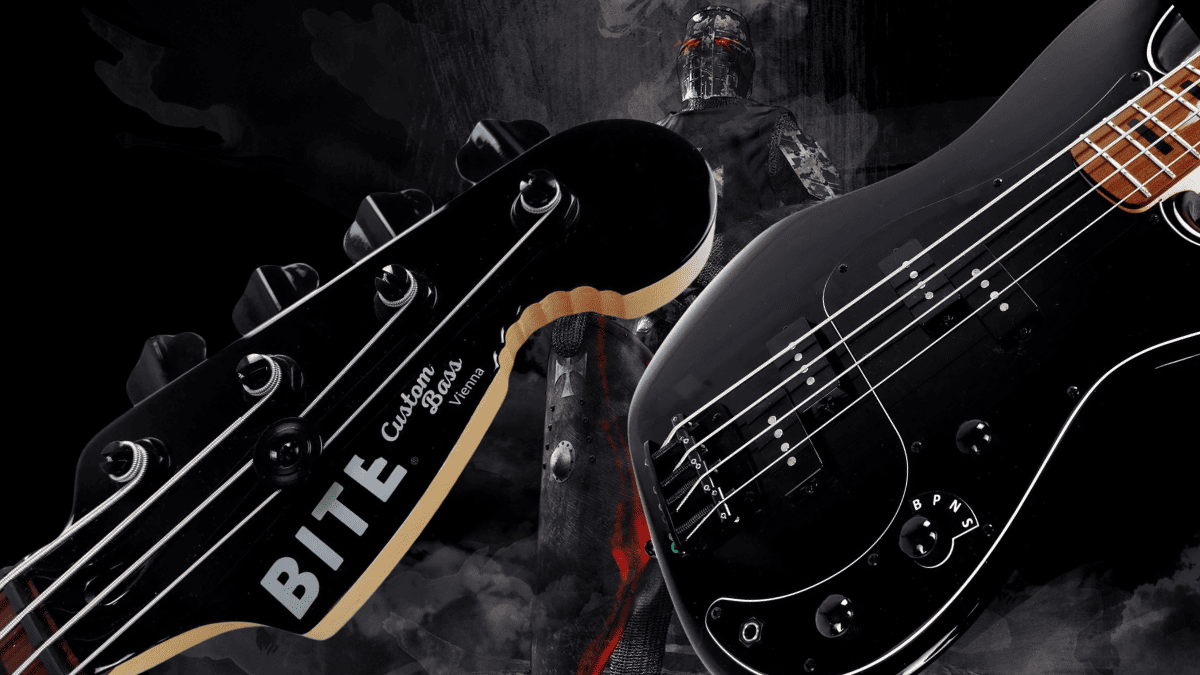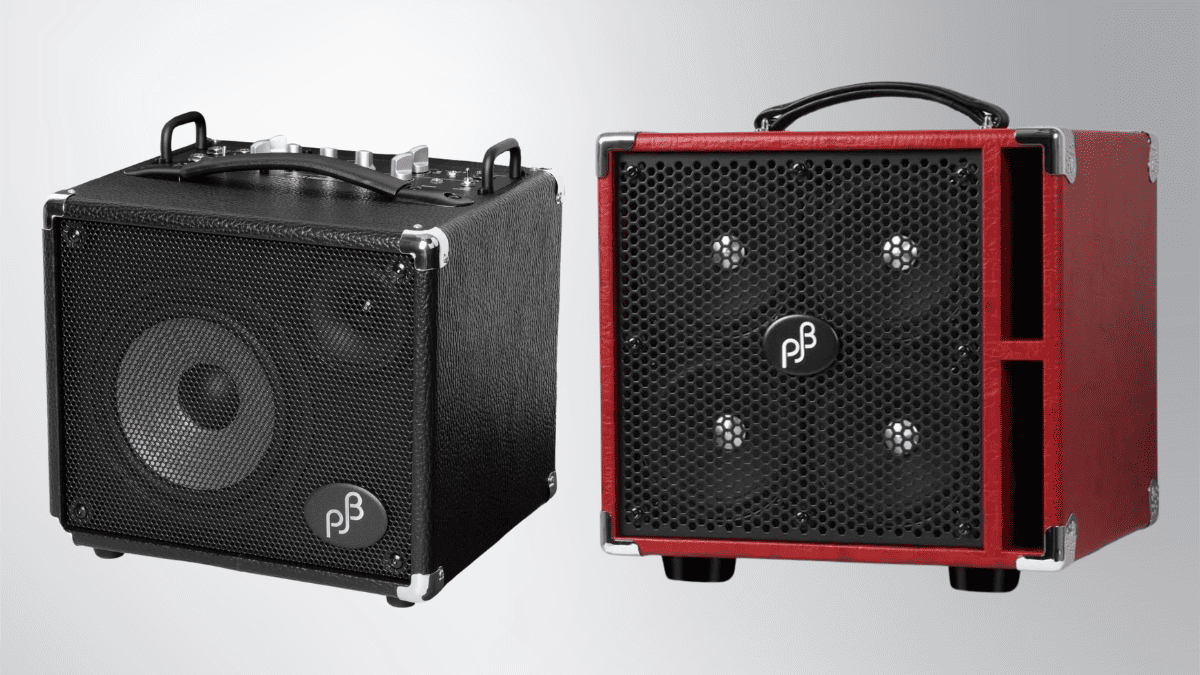Gear Reviews
Review – Wayne Jones Audio WJBP-1, WJ210 and WJ110

If you’ve been following the boutique bass world since the 90’s like I have, the name Wayne Jones Audio might ring a bell.
I first heard about Wayne’s cabs a couple decades back, and although I never had the chance to hear one in person, I was very intrigued by their interesting specs and their relative rarity in the market at that time. Wayne was selling cabs here in the US until shortly after 9/11, at which time, Wayne says, “everything changed”. Cab sales in the US dropped sharply, and Wayne went back to his busy career gigging as a top call bassist. So when I saw Wayne’s gear resurface in the last couple years, I was again intrigued. His current offerings include powered 1×10 and 2×10 cabs, as well as his own stereo tube preamplifier (At NAMM 2017, Wayne introduced a good old passive 210 as well as a 2 channel version of his pre. More below). I reached out to Wayne and he couldn’t have been more gracious or generous with his time and gear. He promptly sent me an array of cabs and his preamp to check out, and I’ve been having a blast with all of it.
Endorser David Dyson at NAMM 2017
Before we get to how the gear works, let’s look at the equipment itself.
At 24” tall, 16” wide, and 22” deep, the 210 dimensions are fairly unique for bass cabs. I asked Wayne about the extra depth of the cabs (both the 210 and 110), and he responded that the depth allows him to not only achieve a desired cubic volume, but also the distance between the driver and the back wall is very intentional, in order to achieve certain performance goals. As a result, the 210 is a somewhat odd form factor. Luckily, it has a built in telescoping handle and tilt back wheels, making the schlep pretty easy. All the gear is covered in a very high quality black carpet, which seems better than a lot of the cab covering I see (Wayne responds: future cabs will use High end automotive leather look Vinyl covering). The preamp had a very nice build quality: all the knobs and switches felt solid and had nice resistance to the pots, thus reducing the risk of bumping controls mid-gig, and boding well for the gears overall lifespan. From a fit and finish perspective, the Wayne Jones gear is simply top notch.
The cabs are powered by a 1000w Pascal power module, which dishes out an incredible amount of tone, fidelity and raw power. The 210 cab gets the full bridged signal of the amp, while the 110 cab can either be run bridged or stereo (allowing for true stereo operation at 500w per side with a pair of the 110 cabs). This is especially hip for users wishing to get the full impact of their stereo reverb, delay or chorus-type effects.
WJBP Stereo valve preamp

The WJBP was as impressive as the cabs, and performed flawlessly for me. Wayne is a fan of the Avalon preamps and the venerable Avalon 737 as a reference point when designing his own preamp. Not only does it borrow from the Avalon’s elegant aesthetics, and superior build quality, it does indeed have that high end tube feel that I remember about the Avalon 737: Tubey, rich and 3D, but super quick, and incredibly clear with ample warmth and fidelity.
The WJBP has a built in defeatable compressor, a 5 band EQ, a low boost, a pan knob (for stereo use) and both an input gain and master volume control, enabling excellent integration with Wayne’s powered cabs. It also features an input pad and built in tuner.
The back panel is fully featured, including a studio grade DI with level control, 2 XLR and 1/4″ outputs, headphone jack and aux input, and a jack for the included footswitch. The 8 stage LED indicators help dial in your preferred gain staging. Generally speaking, I found the WJBP to be super clear and warm, with loads of presence and articulation, and it has that high fidelity depth and weight to each note that I love. It doesn’t do gritty or heavily colored tones, although the powerful 5 band EQ does allow for some serious tone shaping. I really like the broad bass boost, which adds some heft and weight to your overall sound, without muddying things up. Also the onboard compressor, while limited in its parameters, is quite nice. I don’t hear it squashing or pumping, it actually does what it should, which is rarer than one would think, regarding onboard compressor circuits.

It should be noted that Wayne just released at NAMM 2017 a 2 channel version of the preamp, the WJBP11. With a second channel that has a phantom powered XLR input, as well as an additional high treble control (above the existing treble control) the 2 channel preamp is a dream for doublers, or for people who require a 2 channel amp for any number of reasons.
WJ 2×10 powered 210 cabinet

It’s hard to accurately convey the performance of the WJ210. I could say things like “It is the fastest cab I’ve ever heard”, or “sounds like a cab 3 times its size”, or “effortlessly quick and muscular”, but what does all that hyperbole that actually mean? Let me just say: the WJ210 is simply breathtaking in its performance. I’m not saying every single player will find this to be the ultimate sounding bass cab, BUT, you’d be very hard pressed to find one that is more capable at dishing out tone and volume of this caliber. The 210 excels at that wonderfully elusive characteristic I like to call “slam”. For lack of a better definition, (to me) slam is: effortless low end delivery, that is both taut and massive, and a seemingly endless power reserve to dish out transient peaks. It’s one of those cabs that makes you want to play slap lines just for the fun of it. Compared to some other 210 cabs that I really like the slap tone of, the WJ was a clear standout. When playing percussive palm-muted thumb lines, the WJ sounded insanely thick with a super articulate top end that doesn’t have a trace of harshness. The integration of the woofers and tweeter result in a seamlessly tight and clear sound that is aggressive without being brash or harsh in the slightest. All of this results in a powered cab that can handle the demands of a much larger cab, with exquisite tone and composure, in a meticulously constructed box. I seriously can’t imagine opening up a pair of these on a gig, as they put out SO much oomph. Wayne also released passive versions of the 210 cab at NAMM this year, allowing users to stick with their own amplifiers.
WJ 1X10 powered and passive 1X10 cabs

In addition to the amazing 2X10 cab, Wayne sent a pair of his 1X10 cabs for me to check out. I was particularly interested in these not only because I love small modular rigs, but also because of the ability to run TRUE stereo effects without some kind of modified rig. The preamps stereo FX return can be configured to send L/R signals to the pair of cabs, while using just the WJBP, a couple XLR cables and an additional speakon cable. As a reverb and delay junkie, I have to say, I was in hog heaven. I never bother to run my effects in stereo as it always requires some extra gear and produces finicky results. The 1X10 pair on the other hand sounded clear and spacious, with tons of definition. On the gig with the cabs spaced 3-4 feet apart behind me, I was enveloped in 3 dimensional reverb and delay sounds which made chordal and melodic playing seem to jump out in a highly satisfying way. With the pair of 1X10 cabs stacked on their sides (the only way they can stack, with the input jacks and attenuators on the tops of the cabs), the rig sounded similar to the 210, but perhaps a little smoother and less huge in its delivery. I detected a somewhat leaner and less mid-forward tonality out of the 110 pair. The same power module is at play, the 1000w Pascal, but is configured in stereo (500w x 2) which allows one to run true stereo efx or to be run in dual mono, thus maximizing the configurability of the cabs. Like the 2X10, the 1X10’s have attenuators for the mid and high control, which is a nice added level of adjustability and helped me fine tune my sound.
About Wayne Jones custom 10” drivers
OK…. What are my list of gripes (you know I have to complain about something)?
Well for starters, the top mounted jack plates mean that you can’t vertically stack the cabs, and you can’t easily put a rack on top of the cabs. I have heard from users who bought 90 degree IEC, XLR and Speakon jacks and use large rubber feet to create enough clearance, but for my money, I’d like to see amp plates elsewhere on the cabs, to maximize stacking options and not relegate one to custom cables. (Wayne responds: Future cabs will include recessed control plates on all models) I should be mentioned that the WJBP fits squarely on top without any modification needed, so this gripe only applies to those using other preamps or racks. I really prefer to stack 210’s vertically, for a “line array” effect, and the cab layout doesn’t currently allow for that. Also, the powered cabs are XLR connect only, so make sure you bring your XLR/mic cable. Similarly, the WJBP has an external power supply, with a proprietary (non-IEC) connector to the preamp. Don’t leave that power supply at home, or you’re in trouble. (Wayne responds: This was done purposely to Isolate the power supply for complete studio noiseless operation) My only other issue was the limited handle placement. The 210 is not impossible to pick up, but would really benefit from a couple more strategically placed handles, in order to increase its maneuverability in and out of the car and onto the stage.
So what is was my lasting impression of the Wayne Jones gear?
Well. Let’s put it this way: Can you find a simple rig? Yes. Can you find a cheaper rig? Definitely. Can you find a rig that is quicker sounding with more slam and definition? I’m not aware of one! The Wayne Jones gear exceeded my expectations for a truly high performance bass rig, that stands out amongst the crowd of others touting similar results. There is something so compelling about the lightning fast quickness and the massive low end delivery of the WJ rig that remains clear and coherent when other cabs literally start to crumble. The overall tone is extremely clear and linear, but leans toward a forward voicing character that has plenty of teeth to cut through a mix and give your sound some serious weight. I should mention that Wayne has been getting a lot of buzz from guitar and keyboard players as well, which speaks to the gears overall sonic neutrality and flexibility. I would wholeheartedly recommend the WJ gear to anyone looking for unparalleled performance from a bass rig, and specifically for funk, modern R&B and gospel players, seeking a balanced modern tone with lots of edge and, well, slam. All the WJ gear performed beautifully for me on jazz, Latin, fusion, and solo bass gigs, and I’m holding back tears as I prepare to return it! It should be mentioned, that Wayne Jones Audio is based in Australia, but these cabs are proudly “Made in the USA” and shipped from Wayne’s Kentucky based distribution center.
For more information about Wayne Jones Audio, visit them on the web. All of the Wayne Jones gear is sold direct via his website in addition to his dealer network. The powered 210 sells for $2,270, the powered 110 is $1500, the passive 110 is $1200, and the WJBP is $999.

Gear
New Joe Dart Bass From Sterling By Music Man

Sterling by Music Man introduces the Joe Dart Artist Series Bass (“Joe Dart”), named after and designed in collaboration with the celebrated Vulfpeck bassist.
Above photo credit: JORDAN THIBEAUX
This highly-anticipated model marks the debut of the Dart bass in the Sterling by Music Man lineup, paying homage to the Ernie Ball Music Man original that all funk players know and love. The bass embodies many of the original model’s distinctive features, from its iconic minimalist design to the passive electronics.

The design process prioritized reliability, playability, and accessibility at the forefront. Constructed from the timeless Sterling body, the Dart features a slightly smaller neck profile, offering a clean tone within a comfortable package. The body is crafted from soft maple wood for clarity and warmth while the natural finish emphasizes the simple yet unique look.
Engineered for straightforward performance, this passive bass features a ceramic humbucking bridge pickup and a single ‘toaster’ knob for volume control. Reliable with a classic tone, it’s perfect for playing in the pocket. The Dart is strung with the all-new Ernie Ball Stainless Steel Flatwound Electric Bass Strings for the smoothest feel and a mellow sound.

The Sterling by Music Man Joe Dart Bass is a special “Timed Edition” release, exclusively available for order on the Sterling by Music Man website for just one month. Each bass is made to order, with the window closing on May 31st and shipping starting in November. A dedicated countdown timer will indicate the remaining time for purchase on the product page. Additionally, the back of the headstock will be marked with a “2024 Crop” stamp to commemorate the harvest year for this special, one-of-a-kind release.
The Joe Dart Bass is priced at $399.99 (MAP) and can be ordered globally at https://sterlingbymusicman.com/products/joe-dart.
To learn more about Joe Dart, visit the official Vulfpeck artist site here https://www.vulfpeck.com/.
Gear Reviews
The Frank Brocklehurst 6-String Fretless Bass Build

A few months ago, my Ken Bebensee 6-string fretted bass needed some TLC. You know, the one rocking those Pink Neon strings! I scoured my Connecticut neighborhood for a top-notch luthier and got pointed to Frank Brocklehurst, F Brock Music. He swung by my place, scooped up the bass, and boom, returned it the next day, good as new. Not only that, he showed up with a custom 5-string fretted bass that blew me away. I couldn’t resist asking if he could whip up a 6-string fretless for me.
Alright, let’s break down the process here. We’ve got our raw materials: Mahogany, Maple, and Holly. Fun fact – the Mahogany and Maple have been chilling in the wood vault for a solid 13 years. Frank is serious about his wood; they buy it, stash it away, and keep an eye on it to make sure it’s stable.
First up, they’re tackling the Mahogany. Frank glues it together, then lets it sit for a few days to let everything settle and the glue to fully dry. After that, it’s onto the thickness planer and sander to get it nice and flat for the CNC machine. The CNC machine’s the real star here – it’s gonna carve out the body chambers and volume control cavity like a pro.
While the Mahogany’s doing its thing, Frank goes onto the neck core. Three pieces of quartersawn maple are coming together for this bad boy. Quartersawn means the grain’s going vertical. He is also sneaking in some graphite rods under the fingerboard for stability and to avoid any dead spots. The truss rod is going to be two-way adjustable, and the CNC machine’s doing its magic to make sure everything’s just right.
Now, onto the design phase. Frank uses CAD software to plan out the body shape, neck pocket, chambering, and those cool f-holes. I had this idea for trapezoid F-holes, just to do something different. The CAD software also helps us map out the neck shape, graphite channels, and truss-rod channel with pinpoint accuracy.

Once everything’s planned out, it’s CNC time again. Frank cuts out the body outline, neck pocket, and the trapezoid F-holes. Then it’s a mix of hand sanding and power tools to get that neck just how we like it. Oh, and those f holes? We’re going for trapezoids of different sizes – gotta keep things interesting.
Next step: gluing that neck into the pocket with some old-school hide glue. It’s got great tonal transfer and can be taken apart later if needed. Then it’s onto hand-carving that neck-body transition.
For the custom-made bridge, Frank uses brass for definition and Ebony for tonal transfer and that warm, woody sound.
BTW, for tunes, Frank went with Hipshot Ultralights with a D Tuner on the low B. This way I can drop to a low A which is a wonderful tone particularly if you are doing any demolition around your house!
Now it’s time for the side dots. Typically, on most basses, these dots sit right in the middle of the frets. But with this bass, they’re placed around the 1st, 3rd, 5th, 7th, 9th, and 12th frets.
Frank’s got his pickup hookup. Since the pickup he was building wasn’t ready, he popped in a Nordstrand blade to give it a whirl.
It sounded good, but I was itching for that single-coil vibe! And speaking of pickups, Frank showed me the Holly cover he was cutting to match, along with all the pink wire – talk about attention to detail!
A couple of things, while it is important for me to go passive, it is equally important for me to just go with a volume knob. Tone knobs are really just low-pass filters and the less in the way of a pure sound for me, the better.
Finally, it’s string time! As usual, I went for the DR Pink Neon strings. Hey, I even have matching pink Cons…Both low tops and high!
Once we’ve got everything tuned up and settled, we’ll give it a day or two and then tweak that truss rod as needed. And voila, we’ve got ourselves a custom-made bass ready to rock and roll.
I want to thank Frank Brocklehurst for creating this 6 string beast for me.
Gear Reviews
Review Transcript: BITE Custom Bass – The Black Knight PP Bass

This is a written transcript of our video review of the BITE Custom Bass Black Knight PP Bass originally published on March 4, 2024
BITE Custom Bass – The Black Knight PP Bass Review…
Bass Musician Magazine did a review on a Steampunk bass from BITE Guitars about three years ago, it was an amazing instrument, and we were very impressed. Now we’re happy to bring you another BITE bass, the Black Knight PP.
Everybody needs a P-type bass, it’s the standard of bass. If you’re recording, they want you to have a P bass. So why not have something that gives you a little more by having two instead of one P pickup. That’s the idea of this bass, it’s the first thing that leaps out: the double P pickup configuration.
Installing two of their 1000 millivolt split-coil pickups, BITE then went one step further and wired them up in a 4-way parallel/series circuit, a look at the controls reveal a 4-way rotary selector:
The first position, marked “B”, gives you the bridge pickup by itself.
The second position, marked “P”, gives you the bridge and neck pickups in parallel mode, that’s the traditional J-type circuit, it reduces output due to the physical law of parallel circuits.
Position number 3 is marked “N”, it gives you the neck pickup by itself.
And finally, number 4, marked “S”, gives your bridge and neck in a series (humbucking) mode which adds up resistances and thus boosts output. The other two controls are master volume and master tone.
What’s more, like every BITE bass, this one also has a reinforced headstock heel designed to give it extra output and sustain. The BITE website features a graph and explanation of what they have done to the heel, as compared to traditional headstocks.
A look at the body reveals a beautiful Black Blast body finish and underneath that we have alder wood. The bass has a matching headstock with a 4-in-line tuner setup and the traditional bite out of it, so everybody will know what kind of bass you’re playing. The pickguard is 3-ply black, the neck is vintage tinted hard maple and it has a satin speed finish at the back which keeps your thumb from sticking.
On top of that, there’s a clear-coated roasted black locust fretboard with black blocks marking the frets. The nut is a black Graph Tec nut, we’ve got diamond dome control knobs, and the tuners are lightweight compacts with cloverleaf buttons and a 1:17 ratio precision gear. The bridge is a Gotoh brass bridge with 19-millimeter string spacing.
Overall measurements: we’ve got a standard 34″ scale, a 1.65″ width nut and a C neck profile. This bass weighs 8.2 pounds, or 3,7 kilograms for our metric friends, and it uses standard 18% nickel silver frets.
Taking a closer look at the sound, this bass is a joy to play. The BITE proprietary 1000 millivolt pickups deliver an extraordinary amount of output which is surprising considering this is a passive instrument. You may even want to set your amp to active mode because of all of the juice you’re getting out of this guy.
The tonal possibilities are very versatile, it’s a straight P if you want but also much more with those different arrangements of the circuitry. So why have multiple basses when you’ve got one that can give you your basic P plus a lot more?
To sum it up, the Black Knight PP is an amazing instrument. The attention to detail that BITE puts into their basses is second to none. This bass is also amazingly balanced and gorgeous to hold and feel with the satin neck finish.
For more information, visit online at bite.guitars/product/black-knight-pp
Bass Videos
Reviews: Phil Jones Bass Compact Plus 450 and Bass Engine 17

Phil Jones Bass Compact Plus 450 and Bass Engine 17 Reviews…
In this issue, we take an in-depth look at two new amps from Phil Jones Bass, the Compact Plus 450 and Bass Engine 17.
For more information, visit online at pjbworld.com
Bass Videos
Video Review: BITE Custom Bass – The Black Knight PP Bass

BITE Custom Bass – The Black Knight PP Bass Review…
I am sure many of you saw my review of the Snobby Steampunk Bass from BITE Guitars back in February of 2021 and will remember what a remarkable bass it was. BITE has been building custom basses since 2019 and has a unique custom approach where you can configure your bass to your specs.
I am very excited to have another Bass From BITE Guitars in my hands, The Black Knight PP Bass!
The need for a P-Bass in one’s armamentarium is pretty standard for bass players and I recall chatting about this with Marty O’Brien about a year ago. It turns out that Marty and BITE Guitars got together and came up with this excellent configuration that gives you a P-Bass with a whole lot more. Marty even played his own Black Knight PP bass at the 2024 NAMM show. You can see his review here.
Join me as I take an in-depth look at this very cool instrument and share all the details.
Here is The Black Knight Bass from BITE Guitars!
For more information, visit online at bite.guitars/product/black-knight-pp


























